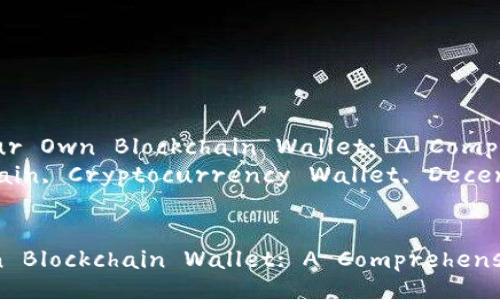Title: Building Your Own Blockchain Wallet: A Comprehensive
- By BitKeep钱包官网
- 2025-06-28 23:02:41
In the burgeoning world of cryptocurrencies, the wallet serves as the gateway to managing, exchanging, and utilizing digital currencies. A blockchain wallet is not merely a storage solution; it embodies the principles of decentralization, security, and user control. This guide aims to provide a thorough understanding of how to build your own blockchain wallet, the different types available, and the technologies involved in the process.
### What is a Blockchain Wallet?A blockchain wallet is a digital tool that enables users to store, manage, and interact with their cryptocurrencies. Unlike traditional wallets that hold physical cash, blockchain wallets store public and private keys. The public key is akin to an address where others can send you cryptocurrencies, while the private key allows you to access and manage those funds securely. The wallet's interaction with the blockchain allows users to send and receive cryptocurrencies, view transaction histories, and keep their assets safe.
### Types of Blockchain Wallets #### 1. Software WalletsSoftware wallets are applications that run on computers or mobile devices. They can be further classified into:
- **Desktop Wallets:** These are downloaded and installed on a user’s computer, providing robust security as they can operate offline. - **Mobile Wallets:** These are apps designed for smartphones, offering convenience and accessibility for on-the-go transactions. - **Web Wallets:** Accessible through web browsers, these wallets allow users to manage their cryptocurrencies without needing to download software. However, security depends heavily on the trustworthiness of the service provider. #### 2. Hardware WalletsHardware wallets are physical devices designed to securely store private keys offline. They provide a high level of security against threats such as hacking and malware, making them ideal for holding large amounts of cryptocurrencies long-term.
#### 3. Paper WalletsA paper wallet is a physical document that contains your public and private keys. It is the most secure method when generated and stored correctly, as it is entirely immune to online hacking attempts. However, it can be easily damaged or lost.
### How to Build Your Own Blockchain Wallet #### Step 1: Understand Wallet ArchitectureBefore delving into the technicalities of building a wallet, it is crucial to understand its architecture. A blockchain wallet contains the frontend, backend, and database. The frontend may include a user interface to facilitate user interaction, while the backend handles the blockchain communication and data storage.
#### Step 2: Choose the Right Technology StackYour choice of technology stack will significantly influence the wallet's development. Common programming languages include JavaScript (for web wallets), Python (for backend functionality), and C (for performance-oriented tasks). Choose frameworks and libraries that can facilitate blockchain interaction, such as Web3.js for Ethereum wallets.
#### Step 3: Develop the User InterfaceThe user interface must be intuitive and user-friendly. Consider using frameworks like React for web wallets or Flutter for mobile applications. Elements to focus on include transaction history displays, balance views, send/receive options, and notifications.
#### Step 4: Implement Wallet FunctionsThe core functions of a wallet include generating keys, signing transactions, and connecting to the blockchain network. Implement functions for creating a new wallet, importing/exporting wallets, and sending/receiving transactions.
#### Step 5: Ensure Security MeasuresSecurity is paramount in cryptocurrency dealings. Implement encryption techniques for private keys, offer backup and recovery options, and consider two-factor authentication (2FA) for added protection against unauthorized access.
### Possible Questions #### Question 1: What Are the Risks of Using Blockchain Wallets?Understanding Security Threats
Blockchain wallets, despite their advanced security measures, are not immune to risks. One of the primary threats is hacking, where cybercriminals gain unauthorized access to wallets and steal funds. Additionally, phishing attacks trick users into revealing their private keys or recovery phrases. Users must also be vigilant about malware, which can compromise their devices and interception attempts on unsecured networks.
#### Question 2: How Do I Choose the Best Wallet for My Needs?Assessing Wallet Options

The best wallet depends heavily on individual needs such as usage frequency, transaction volume, and security concerns. Beginners may prefer user-friendly mobile or web wallets, while experienced investors may opt for hardware wallets to safeguard significant investments. Moreover, the choice between custodial and non-custodial wallets is crucial; custodial wallets allow third-party control while non-custodial ones maintain user autonomy over their keys.
#### Question 3: How Is the Wallet Address Generated?Understanding Address Generation
The wallet address is generated through complex mathematical algorithms utilizing public keys. When a user creates a new wallet, a public/private key pair is generated. The public key undergoes hashing algorithms (such as SHA-256) and encoding processes to yield a wallet address. This ensures the address is unique and prevents easy derivation of the private key.
#### Question 4: What Happens if I Lose My Private Key?Handling Loss of Access

Loss of a private key often leads to permanent loss of access to the associated cryptocurrencies. While some wallets permit backup phrases to recover the wallet in case of lost keys, without these, retrieving lost funds is virtually impossible due to the decentralized nature of blockchain technology. It's essential to back up private keys and wallet recovery phrases securely and consider secure password management options.
#### Question 5: What Role Do Smart Contracts Play in Blockchain Wallets?Smart Contracts: Enhancing Functionality
Smart contracts are self-executing contracts with the terms directly written into code. In the context of blockchain wallets, they can enable automated transactions, enhance security through verification processes, and facilitate complex transaction arrangements without intermediaries. Programming smart contracts requires a thorough understanding of languages such as Solidity (for Ethereum) and can greatly enhance wallet capabilities by introducing programmable finance features.
### ConclusionBuilding your own blockchain wallet is both an instructive and rewarding endeavor. Not only does it deepen your understanding of blockchain technology, but it also equips you with the knowledge to manage your cryptocurrency assets more securely. As the cryptocurrency landscape evolves, so do the challenges and opportunities in wallet development. By taking the necessary precautions and continuing to learn, you can navigate this fascinating field with confidence.
This comprehensive guide covers the essential aspects of blockchain wallet creation; however, always remain alert to prevalent trends and threats in the cryptocurrency ecosystem. Continuous education and adaptation are key to thriving in this space.



